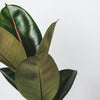Sophora Little Baby and how to care for it

Sophora prostrata , nicknamed in Czech as jerlín, is an interesting type of tree with twisted twigs with small leaves. Grown jerlins can usually be found in city parks, but the "Little baby" cultivar is suitable for households because of its smaller height. Are you interested in its fragile and minimalist appearance? Do you want to know exactly which plant it is and how to properly care for it? You will find answers to these questions in the article.
Meet!
Sophora is a deciduous type of tree that comes from the regions of East Asia (mainly China, Japan or Korea). Among other things, they are grown here for their flowers with medicinal properties. Chinese medicine uses jerlin flowers, for example, to reduce fever or relieve headaches, cleanse the liver or even stop bleeding. According to some sources, flower extracts can be used for various eye-related problems (eg, conjunctivitis).
Sophora prostrata , nicknamed "Little baby", is a cultivar that originates from the cool subtropical South Island of New Zealand. This type of jerlin was originally bred as bonsai, which refers to the ancient art of miniaturizing trees that are grown in bowls. However, Sophora "Little baby" will make a splash in any interior, whether in the form of a bonsai or a classic houseplant.
The small stature of this sophora allows its zigzag-twisted twigs, which are decorated with green oval leaves growing in pairs, to really stand out. "Little baby" is a popular part of interiors due to its delicate to fragile appearance.

Photo: Healthy sophora will not let you sleep thanks to its minimalist appearance
What about her, or care for Sophora
Sophora may seem like an undemanding houseplant, don't be fooled. This small shrub has certain watering or habitat preferences that are worth knowing. Because of their ignorance, he can make his beginner growers suffer a bit
Sophora likes to live in a bright location, the sun really benefits them, which is why, for example, it is possible to leave these houseplants outside in the summer. However, dressing is also related to this. Sophora are prone to overwatering and drying out, so at least the upper part of the substrate must be checked regularly. If this upper part of the soil is dry, we can water the sophora. At the same time, we must check that the plant is not standing in water.
As this is a plant that comes from the cold parts of New Zealand, it will do better where the temperature is lower . Above all, in winter, this shrub will appreciate a cooler environment (e.g. a hallway) where it will not be directly exposed to heating.
Although it may seem that, like other shrubs, sophora will be suitable for shaping, appearances are deceiving! It will probably be because the twigs of this species already grow in interesting shapes by themselves. Sophoram is not very beneficial for shaping and cutting . So with "Little baby" we can forget about scissors and knives and simply enjoy what she comes up with.
Last but not least, the substrate used also plays an important role in the care of sophora. Considering that sophora is susceptible to adequate watering, we help the plant and ourselves by not mixing the substrate too airy . Why? Well, the plant likes to drink, but it is sensitive to drying out or being overwatered - if we use a classic substrate without too much aeration, we won't have to water the plant as much, because the substrate will retain water a little longer. We can add a little perlite to the substrate, but we should avoid any major aeration. Similarly, we can leave out stone or other drainage for this plant, which also contributes to greater drainage of water from the flower pot.
In general, it is recommended to transplant the plant after purchase - especially in winter - into a slightly larger pot at home, which also serves to retain more water for the plant and so we do not overwater.
If we decide to grow sophora as bonsai, we can use special substrates and flower pots - bowls. However, let's keep in mind that, as a bonsai, sophora dries out even faster and therefore watering must be done very carefully while checking its (in)sufficiency.

Photo: Sophora is not a bonsai, but it can be grown as such and is very similar to it
With the leaves down!
If there's one thing more typical of Sophora "Little baby" than its twisted twigs, it's its (literally) stress response . This type of sophora is very sensitive to changes in the conditions in which it is grown. And how can such sensitivity be recognized? Sophora starts shedding its tiny leaves .
At the sight of bare zig-zag twigs, the grower may begin to panic. One of the most common growing mistakes is to think that the sophora is drying out, which leads to overwatering, which leads to another reaction and the jerlin goes down with the leaves again. Stressful situations that can cause your sophora to lose leaves include inappropriate (insufficient/excessive) watering and a change in environment (mainly in temperature and light conditions). Sophora often lose their leaves in winter , when homes begin to heat up and significant temperature differences occur
Fortunately, however, sophora will not remain exposed like this forever. As soon as the tree gets used to the new conditions or the irrigation stabilizes, its twisted branches will start to grow new leaves again. Therefore, let's be patient in the care and allow the sophora the time needed for their acclimatization.
Beware of uninvited guests - bugs!
We, the growers, don't like Sophora . They are also popular with plovers and svilušky . It is therefore appropriate to occasionally check whether one of the mentioned types of pests has taken up residence on your sophora.
Bedbugs are tiny bugs that can resemble aphids. They cluster and suck from the leaves their tissue. Even if you don't notice the bugs themselves, tiny cobwebs can alert you to their presence.
Buds look like a brown box that sticks to the stem or leaf of the plant. it is therefore advisable to check the jerlins in detail. At first glance, the buds can blend in with the stem of the jerlin.
Both mentioned pests can cause considerable damage to the plant, so it is important to act quickly when attacked. To treat sophora , we can use any product that specializes in a certain type of pest, while following the instructions for the specific product. At the same time, let's think about our other green treasures and make sure that pests haven't attacked other plants as well. All infested maids are then quarantined, which ensures that the pests do not spread uncontrollably through the green jungle.

Photo: Almost fallen Sophora Little baby after being attacked by midges
"I personally do not allow products on Careo , either their fertilizer sticks (which I also use as prevention) or the spray, which has never disappointed me yet."
Something to conclude
In conclusion, we can remind you that no air purification or other added value of indoor plants was found for sophora. Although it is not precisely established whether jerlin can be toxic to animals (mainly dogs or cats), its toxicity has been proven to humans. So let's enjoy Jerlín as much as we like without tasting it, and just in case, we will place it where no one can reach it with fingers or claws.
Author: Jana Beránková
-
Posted in
Péče o pokojovky




